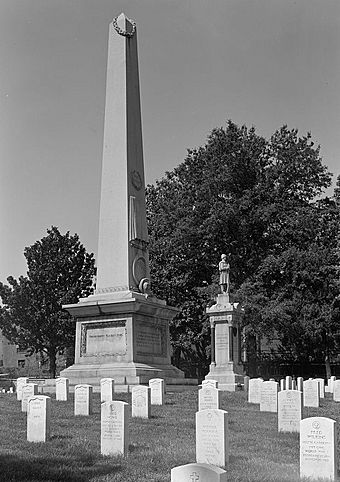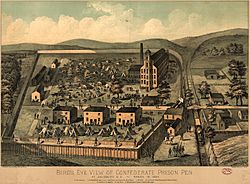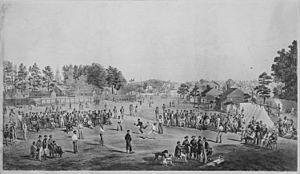Salisbury National Cemetery facts for kids
Quick facts for kids |
|
|
Salisbury National Cemetery
|
|

Unknown Dead Monument with the Maine Monument in the background.
|
|
| Location | 202 Government Rd., Salisbury, North Carolina |
|---|---|
| Built | 1863 |
| Architectural style | Dutch Colonial Revival |
| MPS | Civil War Era National Cemeteries MPS |
| NRHP reference No. | 99000393 |
| Added to NRHP | April 12, 1999 |
The Salisbury National Cemetery is a special burial ground for soldiers and veterans in Salisbury, North Carolina. It was first created during the American Civil War for Union soldiers who died while being held prisoner by the Confederate army.
Today, the cemetery is managed by the United States Department of Veterans Affairs. It covers about 65 acres of land. This includes the original 15-acre site and a newer 50-acre section. In 2020, the YMCA donated another 30 acres, making the cemetery even larger.
As of 2020, over 26,000 veterans and their family members are buried here. Many of the original burials were in large mass graves.
Contents
History of Salisbury National Cemetery
The Salisbury Prison Camp
| Salisbury Prison | |
|---|---|
| Part of American Civil War prison camps | |
| Salisbury, in Rowan County, North Carolina, US | |

Salisbury Prison in 1864
|
|
| Type | Confederate Prison Camp |
| Site information | |
| Owner | Confederate States Government |
| Controlled by | Confederate Army |
| Open to the public |
Yes |
| Site history | |
| In use | September May 1861 – February 1865 |
| Demolished | 1865 |
| Battles/wars | American Civil War |
| Garrison information | |
| Occupants | Confederate soldiers, Union prisoners of war |
In May 1861, North Carolina joined the Confederacy. The Confederate government needed a place to hold prisoners of war. They chose an old cotton mill in Salisbury. This mill had stopped working around 1860.
The mill was sold to the Confederacy. It was a three-story brick building. Later, small houses and a fence were added around it. At first, in December 1861, there were only 120 prisoners. By May 1862, this number grew to 1,400.
In the early days of the prison, prisoners were treated fairly well. They were even allowed to play baseball. A drawing by Maj. Otto Boetticher shows this. It is one of the first artworks to show a baseball game.
By October 1864, the prison held 5,000 men. Soon after, it held 10,000. Salisbury was a small town with only 2,000 residents. The large number of prisoners made the townspeople worried. Diseases also spread quickly.
As the prison became very crowded, conditions got much worse. Many prisoners died from not enough food, poor hygiene, and sickness. The death rate jumped from 2% to 28%. The Confederates buried the many dead soldiers in large mass graves.
Because of these terrible conditions, in February 1865, thousands of prisoners were moved. Some went to Greensboro, North Carolina and then by train to Wilmington, North Carolina. Others were sent to prisons in Richmond, Virginia.
When Union General George Stoneman arrived in Salisbury in spring 1865, the prison was empty. It was being used as a supply storage area. Stoneman ordered the prison buildings to be burned down. He also had a wooden fence built around the mass graves. Today, only one house from the original prison complex is believed to still stand.
Archaeologists have studied the prison site. They used special tools like ground-penetrating radar. In 2017, they found where a former barracks building might have been. More digging happened in 2018.
Creating the Cemetery
The Confederate army first buried prisoners who died at Salisbury Prison near the complex. Records show that between October 1864 and February 1865, 10,321 prisoners arrived. About 3,479 of them died and were buried. Many were placed in 18 long trench graves in a former corn field. They were buried without coffins.
For a long time, people believed 11,700 prisoners were buried there. This number is even on a monument built in 1875. However, newer research suggests the number of burials in the mass graves is closer to 3,800.
After the American Civil War, the site became an official United States National Cemetery. It was set aside for Union soldiers. Later, remains of Union troops from other nearby cemeteries were moved here. Over time, national cemeteries began to accept veterans from all wars.
Modern History and Expansion
The Salisbury National Cemetery was added to the National Register of Historic Places in 1999. This means it is recognized as an important historical site.
By 1994, it looked like the cemetery would soon run out of space. Only spouses of those already buried could be interred. Local officials and veterans asked for help.
On Memorial Day in 1999, the Veterans Administration announced good news. About 40 acres of land were donated for the cemetery. This land was part of the W.G. (Bill) Hefner VA Medical Center in Salisbury. It used to be a golf course.
This new land meant the cemetery could serve veterans for another 50 to 75 years. It made room for 20,000 more burials. The first burial in this new section happened in March 2000.
In April 2000, another 4.7 acres were added. Two years later, a big expansion project began on 31 acres of the former golf course. This project created space for 12,000 more burials.
In November 2011, work started on a new columbarium. This is a place to store urns with ashes. It can hold 1,000 urns. The cemetery also added special "pre-placed in-ground crypts." These allow more burials in less space.
As of Memorial Day 2012, the original cemetery section was mostly full. New burials were only for spouses of those already there. The newer annex section became the main active burial site.
In January 2020, the Rowan County YMCA donated over 30 more acres. This donation means the cemetery annex will have space for burials until at least 2065.
How Many Were Buried?
In 1869, General L. Thomas estimated that 11,700 people were buried. This number is still on the monument to unknown soldiers. However, research by Louis A. Brown suggests the number is closer to 3,800.
Mark Hughes has worked to get the number on the monument changed. He also wants grave markers for the 3,500 men whose names are known from old records. He points out that federal law requires a marker for anyone buried in a national cemetery.
As of 2014, the United States Department of Veterans Affairs did not plan to change the monument. It is hard to know exactly who was buried in the mass graves. In 2009, a sign was added to explain the research about the number of burials.
Important Monuments
- The Federal Monument to the Unknown Dead: This tall granite monument is 38 feet high. It was built in 1875 to honor the unknown soldiers.
- The Maine Monument: This 25-foot high granite monument has a soldier statue on top. It was put up in 1908 by the state of Maine.
- The Pennsylvania Monument: This monument is 40 feet high and stands on a granite base. It was built in 1909.
Notable People Buried Here
- Red Prysock (1926–1993), a veteran and famous R&B saxophone player.
- Earl B. Ruth (1916–1989), a U.S. Representative and Governor of American Samoa.
- John William Smith (1927–2002), a person involved in the 1967 Newark, N.J. riots (buried in the Annex).
- Pvt. "Rupert Vincent", Company H, 3rd New Hampshire Volunteer Infantry. His real name was Robert A. Livingstone. He was the oldest son of Dr. David Livingstone, a famous Scottish explorer.




